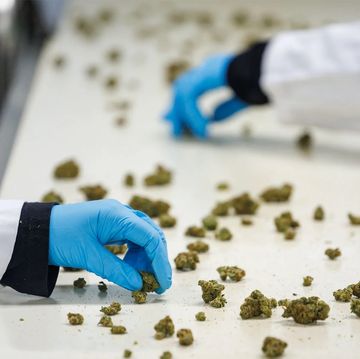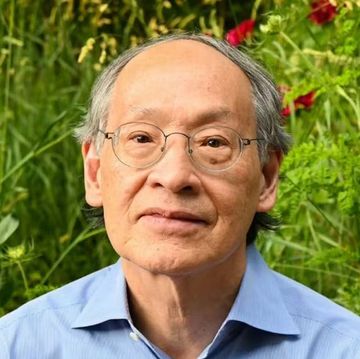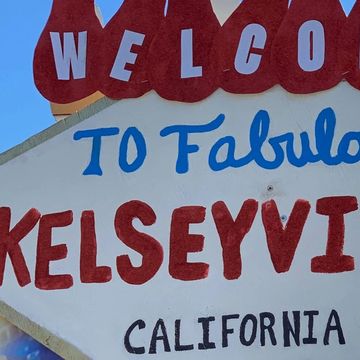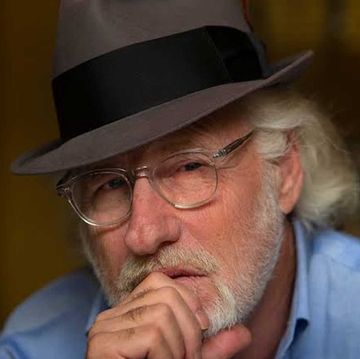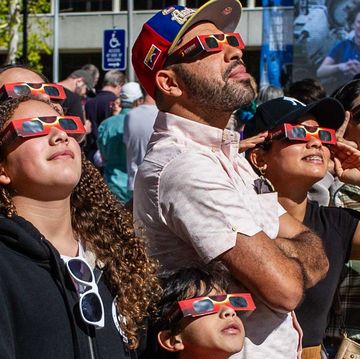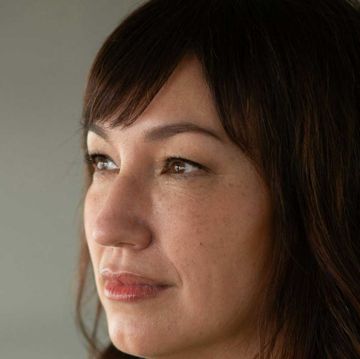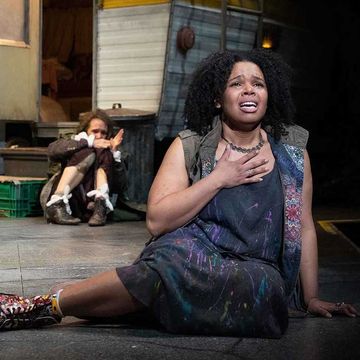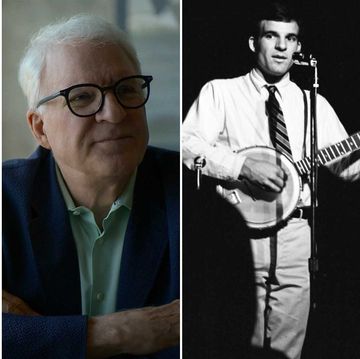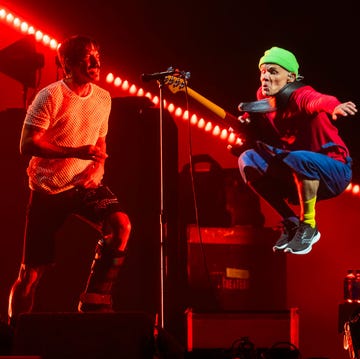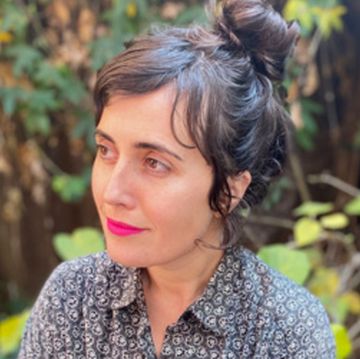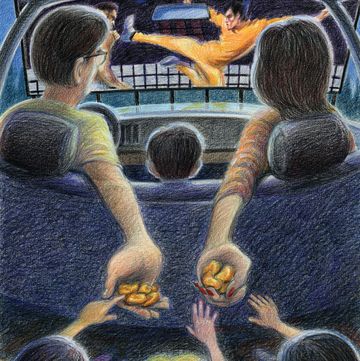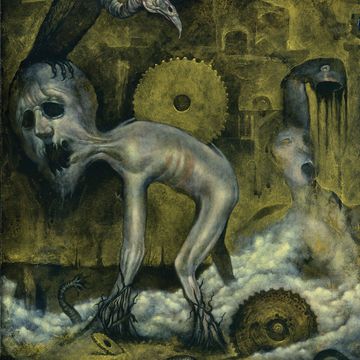From 29 Palms Highway, the Glass Outhouse Art Gallery looks a bit like a miniature golf course. Only instead of windmills, fake rock formations, and impossible bank-shot holes, the attractions include a menagerie of life-size steel animals, a lovely four-pew cedar chapel, and a 15-foot-tall Pepsi can (doubles as a water tank), all connected by a path that’s lined with empty, upside-down wine, juice, and beer bottles stuck in the desert sand.
On this first Saturday in March, the gallery owner, 79-year-old Laurel Siedl, pauses under the shade structure and grips her walker in the midday heat. Behind her, waves of iridescent soap bubbles float skyward from a tiny machine. As a local musician croons Johnny Cash’s “Ring of Fire,” Siedl greets visitors trickling in for an opening reception for 10 artists showing their work at the indoor portion of this nonprofit space. Siedl transformed this dusty lot—a former rabbit farm in Wonder Valley, an unincorporated community that abuts Joshua Tree National Park and attracts a mix of hipsters, tourists, desert rats, and military types (a U.S. Marine Corps base is nearby)—into an eclectic roadside attraction in 2009.
This article appears in Issue 25 of Alta Journal.
SUBSCRIBE
“I know you’ve been here before,” she says, turning to a woman in a wide-brimmed hat, “because you’re wearing a pair of my earrings.” The woman touches her dangling turquoise angel wings and smiles.
“You like my potted palm?” Siedl asks me, pointing to a mannequin arm sticking out of a clay pot and reciting one of her oft-told tales about the works on display. “One of the artists tapped me on the shoulder and said, ‘I heard you could use an extra hand around here.’ ” A French tourist overhears her and laughs.
Siedl, a former school bus driver, welcomes each visitor as she used to greet the kids climbing aboard each morning. With her sparkling blue eyes and one-liners, she’s a magnet that attracts folks to the middle of the Mojave. If she doesn’t greet you on the way in, she’ll eventually catch up with you and tell you stories as you wind through the gallery, or she’ll make sure to show you her art on your way out. Siedl paints animals mostly on found objects like feathers, saws, and vinyl records. She also designs jewelry, makes origami, and crochets hats and blankets. “It keeps me busy,” she says when she takes me to the back room to see her work and talk privately. “They said it would keep me out of the pool halls.”
Siedl grew up in the Sacramento Valley with no electricity and an outhouse. At 15, she married, and by 16, she’d started bartending and playing pool. She had two children with her first husband, who was a member of the Nez Percé tribe. Her second husband was of German descent, and her third husband was from Vienna. In 1982, he and Siedl—who had sold Tupperware and worked for a tech company— moved here from the Bay Area and bought her parents’ five-acre property. They bred rabbits until a 6.8 earthquake massacred the fluffle. In 1989, they divorced. Siedl began driving a school bus to provide for herself.
Although she’d been painting since the age of 8, it wasn’t until Siedl was 65 years old that she created the gallery, with the help of a new groundskeeper, Frank Mezget. He became her fourth husband. Inspired by the Texas roadside attraction Cadillac Ranch, they also built a sculpture garden by sticking old bicycles in the ground and fashioning works from cast-off material. The surreal sculptures reflect Siedl’s dark humor: In Ghoul’s Gym, a bunch of skeletons pump iron. The gallery’s namesake—two booths, each containing a toilet and whose doors and walls are one-way mirrors—serves as its public restrooms. While doing their business, occupants enjoy a lovely view of the Pinto Mountains and the uncanny sight of other visitors milling around and occasionally pressing their faces against the glass. It’s a humorous and democratic experience.
There are no snooty gatekeepers at the Glass Outhouse, by design. For years, Siedl had paid dues to galleries that would never display her paintings, so here, if an artist wants a show, they stop by and sign up on the wait list. Presently, the space is booked until January 2025. The only rules: no pornography and no politics. Siedl doesn’t believe one person’s art is better than another’s and says that there’s a painting out there for everyone. “Frank’s work used to sell like crazy,” she says of her fourth husband’s art. He used acrylics on slate and painted landscapes with old cabins and churches. One piece didn’t sell quickly, and he threatened to paint over it. “I told him, ‘Just wait. The right person hasn’t seen it yet.’ ” Sure enough, his painting sold.
We’re now seated inside the gallery on mismatched chairs by the front door, catching the spring breeze. Siedl has made me feel comfortable enough to ask whether Frank is still alive. The landline rings, and she makes her way over to the phone. Someone wants to know the gallery hours. When she sits back down, she looks off into the distance and tells me that Frank died in her arms. “God, I loved that man,” she says. “It took me damn near 70 years to find the right guy. I had to kiss a lot of frogs. What can I tell you?”
The Glass Outhouse Art Gallery is closed on Mondays and open from 1 to 5 p.m. the rest of the week, but the grounds are accessible from dawn to dusk. There are no fees to visit the gallery or the chapel, but donations are accepted. The chapel is open for weddings. Eight couples have been married there. And if you need a witness, you can knock on Siedl’s door. She is usually there unless she has a doctor’s appointment or it’s Sunday morning and she’s playing pool at a local restaurant. “I don’t get out much,” Siedl says. “I stuck myself here.”
Before I go, I buy a vinyl record with a beige-and-white French bulldog painted on it. It looks exactly like my dog. Friends ask me if I had it commissioned. There is a painting here for everyone.•
Jennifer Lewis is the editor in chief and publisher of Red Light Lit, a small press and reading series established in 2013. She is the author of the short story collection The New Low, published by Black Lawrence Press.


